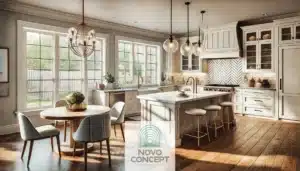Furniture plays a crucial role in shaping the overall atmosphere and functionality of your home. The right pieces not only enhance your space aesthetically but also improve comfort and flow. In this article, we’ll explore 20 practical furniture design tips that will elevate your home’s style while ensuring that it remains functional and inviting. Whether you’re redesigning your living room, bedroom, or any other space, these article from Novo Concept have some tips are designed to help you make the most of your furniture layout and selection.
20. Choose Multi-Functional Pieces
Maximizing space in smaller homes can be a challenge, but multi-functional furniture solves this problem beautifully. Think of ottomans that double as coffee tables, sofa beds for guest rooms, or storage benches that serve both as seating and space savers. These versatile pieces allow you to create a stylish, functional environment without cluttering the space.
19. Stick to a Cohesive Color Palette
When designing your home’s furniture layout, consistency is key. A cohesive color palette helps tie together different pieces and avoids creating a chaotic or mismatched look. Stick to complementary colors for your furniture, fabrics, and accessories, and consider using neutrals as a foundation with pops of color to add interest.
18. Prioritize Comfort Over Aesthetics
While it’s tempting to buy beautiful, eye-catching furniture, comfort should always be a priority. After all, your home is where you relax and unwind. Choose pieces that offer both style and comfort, such as sofas with soft cushions or ergonomic chairs that provide support during long hours of use.
17. Use Rugs to Define Spaces
Another furniture design tips is that rugs are not only functional but also serve as a great design tool to define different areas within an open-plan space. In living rooms or dining areas, use rugs to anchor furniture and create clear zones. Make sure the rug is large enough to fit under at least the front legs of your furniture to help ground the space visually.
16. Don’t Overcrowd the Room
When arranging furniture, resist the temptation to fill every corner. Overcrowding a room with furniture can make it feel cramped and difficult to move around. Leave ample space between pieces to ensure easy flow and comfort. In large rooms, consider grouping furniture to create cozy zones without overwhelming the area.
15. Consider Scale and Proportion
Scale and proportion are essential when selecting furniture for your home. A massive sectional in a small living room can feel overpowering, while tiny chairs in a spacious room might look lost. Pay attention to the size of your furniture in relation to the room, and choose pieces that complement the space’s scale for a more balanced and harmonious look.
14. Keep Traffic Flow in Mind
In any room, it’s important to plan for natural traffic flow. Furniture placement should allow people to move comfortably throughout the space. Avoid placing large pieces in walkways, and ensure there’s enough space for easy movement between furniture items. This creates a more functional layout and ensures the space feels inviting.
13. Layer Lighting for Ambience
Lighting plays a pivotal role in creating atmosphere. Use a mix of ambient, task, and accent lighting to illuminate your furniture and the entire room. Consider floor lamps, table lamps, and overhead lighting to create depth and highlight your furniture. Proper lighting can accentuate the beauty of your pieces and set the mood for your space.
12. Mix Textures for Depth
Combining different textures adds richness and depth to your furniture arrangement. Don’t be afraid to mix materials like wood, leather, and fabric. For instance, pair a plush fabric sofa with a sleek metal coffee table or a leather chair with a soft wool rug. This contrast brings visual interest and makes your space feel more dynamic.
11. Create Balance with Symmetry
Symmetry can make a room feel more organized and visually pleasing. When arranging furniture, aim for a balanced look. For instance, place matching side tables on either side of the sofa or use identical armchairs across from each other. Symmetry helps establish a sense of harmony, particularly in larger rooms, and prevents the space from feeling too chaotic or uneven.
10. Incorporate Statement Pieces
Every room can benefit from a standout piece of furniture. Whether it’s an elegant armchair, a bold coffee table, or a striking bookshelf, statement pieces serve as conversation starters and add personality to your space. Just make sure the rest of the furniture complements it, rather than competing with it, to maintain a cohesive look.
9. Use Vertical Space
If you’re limited on floor space, make the most of your vertical space. Tall shelves, bookcases, and even wall-mounted furniture can free up valuable floor area while providing storage or display options. Vertical design elements not only maximize space but also draw the eye upward, making the room feel taller and more open.
8. Choose Quality Over Quantity
It’s easy to accumulate lots of furniture, but sometimes less is more. Focus on investing in high-quality pieces that will last longer and provide more comfort than numerous lower-quality items. Quality furniture, especially when it’s well-maintained, can elevate the entire look and feel of your home while saving you money in the long run.
7. Consider the Room’s Purpose
When selecting furniture, always keep in mind the primary function of the room. For example, a family room should have comfortable seating that encourages relaxation, while a dining room should feature a table and chairs that facilitate conversation and meals. Tailor your furniture choices to the specific needs of each space to enhance both its style and functionality.
6. Make Your Furniture Work for You
Instead of purchasing individual items without considering their practical use, look for furniture design tips that serves multiple functions. Ottomans that double as storage, coffee tables with hidden compartments, and fold-out desks are all great options for making the most of your space. Multi-functional furniture can help you maintain a clutter-free environment while still offering all the essentials.
5. Let Your Furniture Flow
Furniture arrangement should create a natural flow within the space. Whether you’re designing a cozy living room or a sprawling open-plan area, ensure that there’s a logical path between pieces that doesn’t feel congested. Flow is key for both aesthetic appeal and ease of movement—nothing should feel isolated or out of place.
4. Think About Scale When Choosing Art and Accessories
Just as scale matters with furniture, it’s equally important to consider the size and proportions of accessories and art pieces in the room. A massive painting on a tiny wall can overwhelm the space, while small art pieces on a large wall might seem lost. Ensure that your artwork and decorative items are proportional to the furniture and the size of the room to create visual harmony.
3. Focus on Functional Layouts
Even though furniture arrangement is an opportunity to showcase your style, the layout should primarily be functional. The seating should be arranged in a way that fosters conversation and accessibility. For instance, in a living room, make sure the sofa faces the TV or focal point, and arrange chairs to encourage social interaction without obstructing pathways.
2. Pay Attention to the Furniture design tips
It’s often the small details that bring a room’s design together. Subtle touches like decorative cushions, stylish throw blankets, and coordinating lamps can elevate the look of your furniture and add personality to your home. These little accents can make all the difference in creating a warm and inviting environment.
1. Keep It Comfortable
At the end of the day, your home is meant to be a comfortable and welcoming space. No matter how stylish or trendy your furniture is, comfort should be the top priority. Prioritize plush cushions, ergonomic chairs, and cozy fabrics to ensure that your furniture not only looks great but feels great, too. After all, a stylish home should also be a functional and comfortable one.
Conclusion
By incorporating these 20 furniture design tips into your home, you can create a space that’s both functional and visually stunning. Whether you’re working with a small apartment or a large home, these suggestions will help you make the most of your furniture layout, storage, and décor. Remember, good furniture design balances style, comfort, and functionality, and by paying attention to these details, you’ll enjoy a home that’s stylish and tailored to your needs. Start implementing these tips today and transform your home into the perfect blend of comfort and style.







